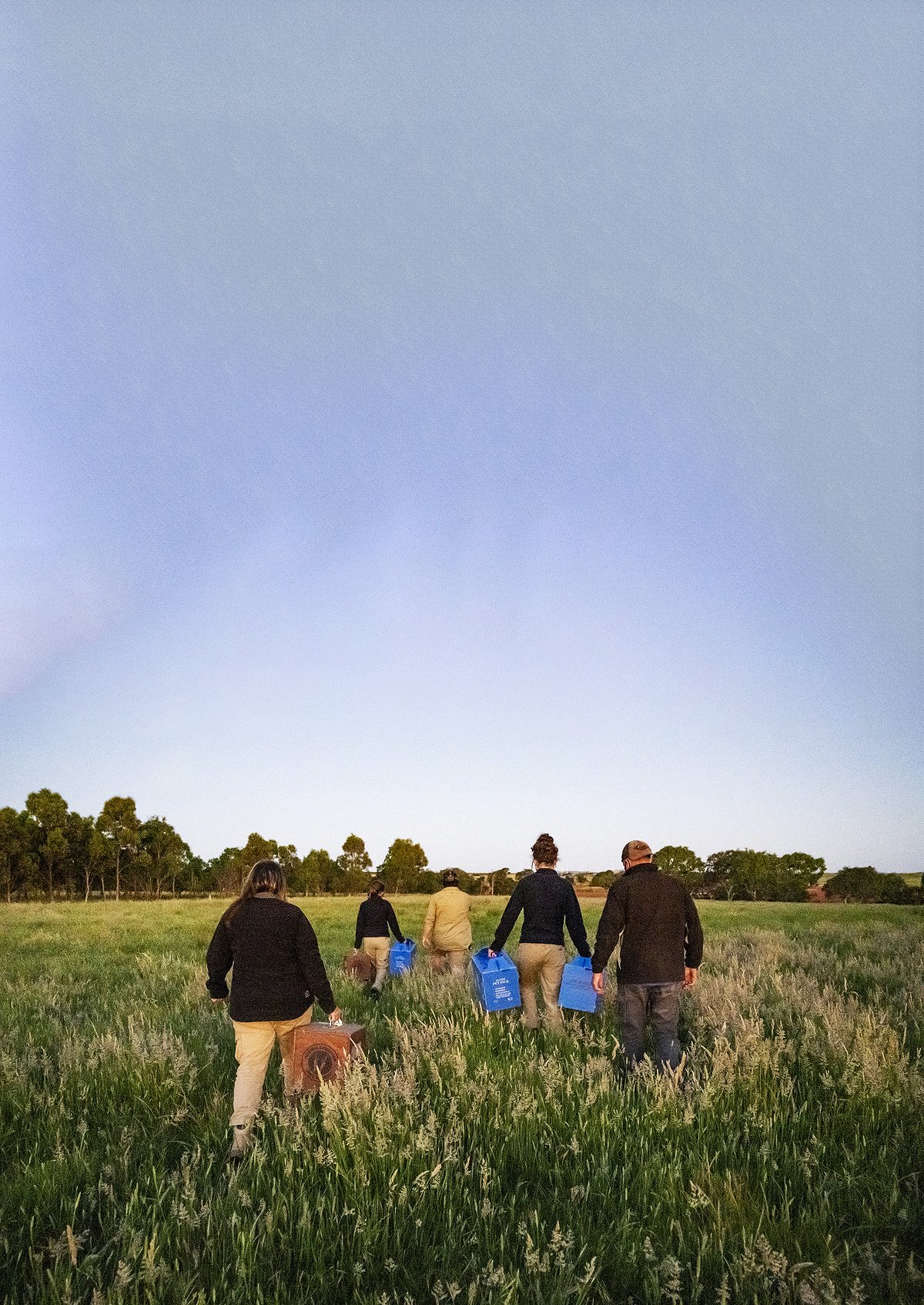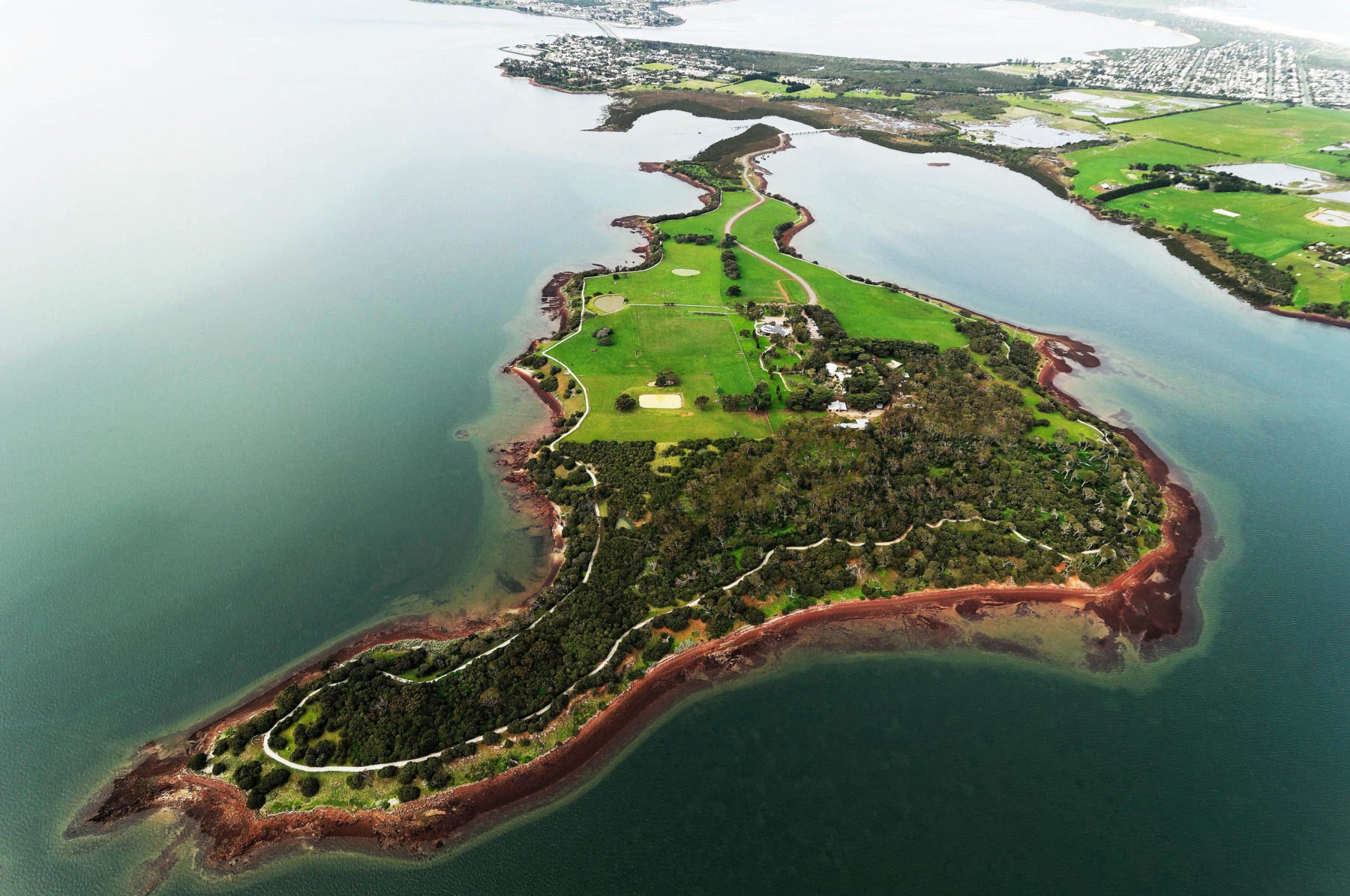Eastern barred bandicoot: how the little diggers rebounded

IT’S ALMOST dark at Woodlands Historic Park, a swathe of native grasslands just north of Melbourne Airport, where a small crowd has gathered with torches to witness a historic event. But the star of the show, an eastern barred bandicoot named James, has come down with a bout of stage fright and is refusing to come out of his crate. After some gentle coaxing from his keeper, James hops out of his box and stands blinking in the twilight, his tall ears and pointed nose casting a long silhouette. A moment later he turns and shoots away, disappearing into the tall grass.
It might be one small bound for this bandicoot, but it’s a giant leap for bandicoot-kind! James is joining a thriving population of nearly 1500 of a bandicoot species that’s now scattered across Victoria. Three decades ago the species was teetering on the precipice of extinction in the state.
Eastern barred bandicoots were once common across the grassy volcanic plains of western Victoria and numbers were once estimated to be in the tens of thousands. The region’s lava-enriched soil was ideal for agriculture, and during the 19th and early 20th centuries the land was extensively cleared for farming.
Habitat loss, combined with predation by feral cats and foxes, led to a rapid decline in bandicoot populations. By 1989 only 150 were known to have survived – in one last remaining population discovered living a fragile existence among abandoned cars at a tip outside the regional town of Hamilton.
Realising the species was nearing its last gasp, the Victorian government convened a dedicated recovery team of government agencies, private investors, conservationists and volunteers to save the marsupial species. Forty bandicoots were captured at Hamilton to form the basis of a new captive breeding program at Melbourne Zoo. Soon after, the eastern barred bandicoot was officially declared extinct in the wild in Victoria.

Learning from mistakes
Eastern barred bandicoots are nocturnal, rabbit-sized marsupials with faint white stripes across their rounded rumps. They weigh less than 1kg and have powerful hind legs that allow them to move quickly and leap as high as 1.8m into the air. They are also superb ecological engineers. A single bandicoot can turn over an estimated 13kg of soil in one night in pursuit of insects such as grub-like beetle larvae, a process that aerates and enriches the earth.
Fortunately, bandicoots have the second-shortest pregnancy of any known mammal – 12 and a half days – faster than even rabbits or mice. This means that, if all other threats are removed, it stands a good chance of recovery through breeding. After feeding her joeys in one litter for little more than two months, a mother is ready to breed again. She can have up to five litters a year.
Playing to the species’ reproductive strength, “the focus was on building up the number of bandicoots as quickly as possible to release back into the wild”, explains a reproductive biologist at Zoos Victoria, Dr Marissa Parrot, who oversaw the captive breeding program. Throughout the 1990s, captive-born bandicoots were released on six occasions, but none survived. After a series of misfires, it became apparent that foxes were responsible for the failure.
“Foxes thrill-kill. People see this when a fox gets into a chicken shed. The fox will kill all the chickens but maybe only take one, whereas feral cats don’t tend to do that,” says a threatened-species biologist at Zoos Victoria, Dr Amy Coetsee, who oversaw the release of bandicoots. “Our reintroduction attempts ultimately failed because of the foxes. We realised we can only send bandicoots into areas that can be maintained fox-free.”
The new recovery strategy, developed with this knowledge, pivoted towards finding fenced habitats where bandicoots could be safely reintroduced. However, less than 1 per cent of Victoria’s native grasslands remain, and an even smaller portion of that is on public land or fenced.
Salvation came in 2004 when Nigel Sharp – who went on to found conservation charity Odonata in 2017 – led a consortium of private and public investors to purchase 450ha of former sheep-grazing land at Mount Rothwell, 50km west of the Melbourne CBD, to create a sanctuary. The land was degraded and required significant restoration, as well as new predator-proof fencing, before bandicoots could be safely introduced that same year.
Today, the Mt Rothwell Biodiversity Interpretation Centre is home to about 70 per cent of the state’s bandicoot population. It also functions as a grassland carbon program where property developers can offset emissions from construction by contributing financially to renewing Victoria’s grasslands.
Nigel says healthy ecosystems and biodiversity are essential when it comes to combating climate change. “If we’re going to draw down carbon, it’s going to be through our land, and that means we need healthy ecosystems, which is why it’s important to look at the combination of animals in the landscape to get the ecosystem working again,” he says.
“When bandicoots were first introduced, the soil was really compacted, but this has changed. Eastern bettongs help turn over the soil while bandicoots poke holes with their snouts.” This process allows vegetation to grow and attracts more wildlife, such as insects and birds, which play a role in sustaining the wider ecosystem.
Mt Rothwell’s success laid down the blueprint for developing future sites, such as a 1000ha merino sheep grazing farm at Tiverton, another Odonata property, whose bandicoot population will soon eclipse that of its sister site. Nigel says a new 211ha site is currently being prepared at Orana Sanctuary, 40 minutes from Bendigo.
Meanwhile, Conservation Volunteers Australia has been working to restore the grasslands of Woodlands Historic Park, harnessing the efforts of community and corporate volunteers to cultivate the land in preparation for reintroducing bandicoots. A constellation of other sites managed by Zoos Victoria and Parks Victoria, including at Hamilton, Skipton and Dunkeld, means there will be a total of seven fenced sites for bandicoots. Together, they will act as insurance locations should one site be affected by a catastrophic natural disaster or predation.

Island expansion
The recovery team’s success in introducing bandicoots at fenced locations caught the attention of Dr Duncan Sutherland, deputy director of research at Phillip Island Nature Parks (PINP). He approached the team with the idea of turning Victoria’s southern islands – French, Phillip and Churchill – into fenceless bandicoot havens. “In 2012 we were working very hard to eradicate foxes from the islands and if we could pull that off they would become a very large area of fox-free habitat that could be critical for the survival of some species,” Duncan recalls. “We thought eastern barred bandicoots needed a leg up and that we might have the solution.”
Fencing is an expensive solution and not sustainable in the long term, which is why Duncan’s proposal was quickly backed by the Victorian Department of Environment, Land, Water and Planning (DELWP) and Zoos Victoria, but there were still hurdles to overcome. For one, the islands were not part of the bandicoots’ historic range and there was a real question whether they could thrive in a coastal setting. Bandicoots would need to be able to move freely across private farmland too, which meant the team would need the support of the islands’ residents.
The plan to introduce bandicoots received an icy reception when it was first floated at a community information evening on French Island. The community’s concern was justified. Koalas aren’t native to French Island but they were introduced in the late 1800s, rapidly exploded in numbers and began to overgraze the trees. Residents weren’t keen on repeating the mistakes of the past.
“We really wanted to listen to their concerns and curiosity, and to demonstrate that bandicoots weren’t going to become another pest,” Duncan says. “While bandicoots have high reproductive potential, we saw at other reserves that once they reach maximum density, they begin to contain themselves.” To prove this, the recovery team established a test case population on Churchill Island, an accessible island with few human residents that replicated the conditions of Phillip and French islands. In 2015 bandicoots were quietly introduced and allowed to flourish, while the team worked hard to rally support from residents with presentations and meet-and-greets.
To say the bandicoots took well to island living is an understatement. While conducting surveys, Amy found the marsupials had become especially fat after gorging on crustaceans. She jokes that a new “Churchill Island” category for weight assessment was added to their data collection criteria. More importantly, the population had self-regulated as the team had expected.
Soon after, the team took residents out to Churchill Island on a night-time tour to see the bandicoots for themselves. The locals were so delighted by their new neighbours that they embraced them, many signing up to assist PINP and Zoos Victoria with night-time releases and surveys. Thanks to their talent for churning soil, which helps to enrich agricultural land, farmers came to see bandicoots as their partners in land management.
With the island communities behind them, more bandicoots were introduced to Phillip Island in 2017 and then French Island in 2019, where they have now established successful populations.

Deepening the gene pool
By the end of 2019 there were more bandicoots in the wild than in captivity. The range of reintroduction sites across the mainland and islands meant that even if foxes got into one site, there were insurance populations elsewhere. Scientists had produced a significant body of knowledge about bandicoots after three decades of research, including a breeding manual. Marissa says there was a lightbulb moment when it was realised the reasons why a bandicoot program was created no longer existed. In September 2021, the conservation status of eastern barred bandicoots in Victoria was reclassified to endangered, marking the end of the 33-year breeding program.
Marissa believes it’s an an Australian first. “We don’t know of any other program where we’ve been able to take a species that was extinct in the wild, run a long-term program, and then have them safe enough to actually shut down that captive breeding program,” she says.
Richard Hill, a DELWP senior biodiversity officer who was also chair of the Eastern Barred Bandicoot Recovery Team, says the closure of the breeding program marks a new beginning. The focus is now on joining the different fenced and island locations as part of a broader “metapopulation” strategy aimed at strengthening genetic diversity. Every bandicoot currently in the wild can be directly linked to the 40 bandicoots rescued in 1989. “No captive breeding program can conserve genetic diversity, and by 2009 these animals had lost nearly 40 per cent of their genetic fitness,” Richard says. A broad gene pool is crucial for ensuring bandicoots don’t develop genetic defects and helps make populations more resilient to the effects of climate change.
Researchers from the University of Melbourne are now moving wild bandicoots between locations to help mix the gene pool. A dozen bandicoots from Tasmania, interstate relatives of the Victorian eastern barred bandicoot, were also imported and introduced as part of a trial program to improve genetic fitness.
James Todd, DELWP’s executive director of biodiversity, says the bandicoot recovery program required a cast of thousands working over the course of generations, bringing together a wide range of people with different skills to achieve a common purpose. “There’s no one organisation that holds the knowledge or capability to save a species on their own. It requires absolute collaboration across agencies, non-government organisations, traditional owners, landholders, volunteers and communities.”
James says the success in saving the eastern barred bandicoot should be a source of hope for all Australians. It’s proof that when we work together, we can overcome significant environmental and conservation challenges.




